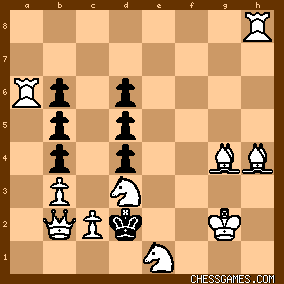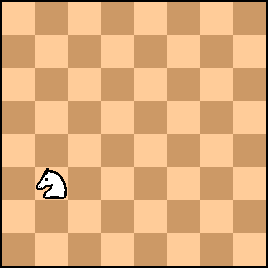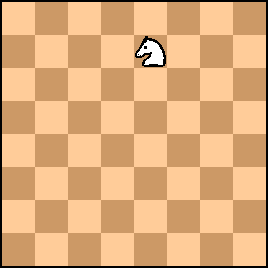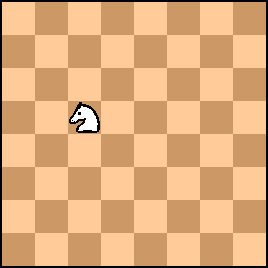|
< Earlier Kibitzing · PAGE 5 OF 5 ·
Later Kibitzing> |
Sep-17-13
 | | Penguincw: R.I.P. Koltanowski. |
|
Dec-13-13
 | | GrahamClayton: Back in 1952, Kolty hosted a chess program on radio station KPFA of Berkeley, California, commencing each Friday night at 9.00 pm. He played a game against the station's listeners, and then analysed the game in future broadcasts. Would anyone know for how long this program ran on KPFA? |
|
| Jul-24-14 | | diagonal: http://www.chessdryad.com/articles/...
<George Koltanowski: Father of Northern California Chess> |
|
Sep-17-14
 | | Penguincw: R.I.P. blindfold chess legend, Georges Koltanowski. |
|
| Sep-17-14 | | docbenway: Koltanowski was an official at a Paul Masson Winery Chess Tournament in the early 1970s and was drawn to a table where 2 guys were playing Las Vegas Chess and slamming the plastic container so hard into the table it seems they would soon drive it right through. He watched for a few moments and bent forward to quietly say, "Gentlemen, maybe somebody would like to play after you." They corrected in mid stream but he was already gone. |
|
| Sep-17-14 | | parisattack: <GrahamClayton: Back in 1952, Kolty hosted a chess program on radio station KPFA of Berkeley, California, commencing each Friday night at 9.00 pm. He played a game against the station's listeners, and then analysed the game in future broadcasts. Would anyone know for how long this program ran on KPFA?> The medium is the message, and Kolty appears to have used them all successfully. I have an old LP record "Koltanowski Teaches Chess - Part 1 - My Approach to the Game." It is quite a hoot, as they say in the midwest. |
|
| Sep-17-14 | | Lighthorse: In the late 1960s, they had a TV program on PBS here in NY with him that I watched faithfully called "Koltanowski on Chess." I still remember he had one lesson on how to do blindfold chess. I tried his method, but never could master it. I also remember his comment that they banned blindfold chess in the USSR, but didn't they realize that imagining moves over a chessboard is almost the same thing? |
|
| Sep-17-14 | | Lighthorse: Although I lost my notes long ago from the Koltanowski TV show, I did memorize this one great problem he showed. Here it is for posterity: Initial position: 
click for larger view
White to play and mate with the c2 pawn without capturing any of the black pawns or allowing them to move. Here is the solution:
1.Qd1 Kh8 2.Qa1 Kg8 3.Ng3 Kh8 4.Ng2 Kg8 5.Ne2 Kh8 6.Ne1 Kg8 7.Nc1 Kh8 8.Rf8+ Kg7 9.R6f7+ Kh6 10.Rh8+ Kg5 11.Bh4+ Kg4 12.Bf5+ Kf4 13.Ncd3+ Ke3 14.Qb2 Kd2 15.Kf2 Kd1 16.Kf3 Kd2 17.Ra7 Kd1 18.Ra6 Kd2 19.Bg4 Kd1 20.Kg2+ Kd2

click for larger view
21.c4+ Ke3 22.Qc1+ Ke4 23.Bf3+ Kf5 24.Qg5+ Ke6 25.Bg4+ Kf7 26.Bh5+ Ke6 27.Rh6+ Kd7 28.Qd8+ Kc6 29.c5

click for larger view
29...Kb7 30.Qa8+ Kc7 31.Bd8+ Kd7 32.c6#

click for larger view |
|
| Sep-25-14 | | parisattack: Very nice puzzle <Lighthorse>! Thanks for sharing. |
|
Aug-30-15
 | | Phony Benoni: A comment from Koltanowski's report on the 1969 US Open ("Chess Life & Review", November 1969, p.438): <"A number of players, including a former U.S. Champion, do not resign but just get up and leave the room, allowing their time to run out. And they call themselves "masters!"> Inquiring minds want to know who the U.S. Champion was. If Koltanowski meant somebody at the tournament, it would have been either Arthur Bisguier or Arnold Denker. Had he been speaking in general, he could also have meant Sanuel Reshevsky, Larry Evans, or Robert Fischer. I have a suspect or two, but facts would be better. |
|
| Aug-30-15 | | TheFocus: Blindfold chess, huh?
I never could see it. |
|
| Aug-30-15 | | TheFocus: <Had he been speaking in general, he could also have meant Sanuel Reshevsky, Larry Evans, or Robert Fischer.> Not Fischer. He only lost two games by running out of time. And Fischer wasn't playing in U.S. Opens by 1969. |
|
Aug-30-15
 | | Phony Benoni: No, we can be sure it wasn't Fischer. In the first place, it would have been widely commented upon and become general knowledge. And in the second place, it would have become the fashion. |
|
| Aug-30-15 | | NeverAgain: And in the third place, you can hardly expect to be taken seriously if you start citing Koltanowski as a reliable source. http://www.chesshistory.com/winter/... |
|
Aug-30-15
 | | Phony Benoni: Yes, Koltanowski was never one to let facts stand in the way of a good story. But this sounds more like the complaint of an aggrieved tournament official, or perhaps an older man disgusted with the morals of the young generation. And, in any event, it must be better to look into the statement rather than rejecting it outright simply because Koltanowski said it. |
|
| Feb-21-16 | | bengalcat47: <docbenway> I'm curious about "Las Vegas Chess." Is this a drinking man's variation of chess, or is there gambling on the game's outcome? Just wondering is all. |
|
Apr-13-16
 | | GrahamClayton: <parisattack>
I have an old LP record "Koltanowski Teaches Chess - Part 1 - My Approach to the Game." It is quite a hoot, as they say in the midwest.<parisattack>,
Here is the album cover - was there ever a Volume 2 released?
http://lpcoverlover.com/2016/03/22/... |
|
| Jun-04-17 | | ChessHigherCat: <Lighthorse: White to play and mate with the c2 pawn without capturing any of the black pawns or allowing them to move.> That's a cool puzzle but you should say "White to mate with the c pawn" (not c2 pawn), because I thought it was necessary to play c2 to c3 or c4 with a discovered check and mate. |
|
| Apr-14-18 | | wordfunph: from Chess Digest Magazine 1971 May by Koltanowski.. <GHOSTS
In a foreign cafe two excitable gentlemen were playing chess, White giving the odds of Queen's Rook. After some opening moves White played his King from K to QB1. "One square at a time," explained Black.
"Not at all" retorted White. "I castled Queen's side." "Castle" cried Black. "Why you haven't a Rook!"
"I give the odds of a Rook," loftily replied the other, "but that doesn't prevent my castling with the ghost of my Rook." Personally I thought the move if not actually bad, at least innocuous; but White knew its psychological value. His adversary was so nettled at what he termed a low-down trick that, making one mistake after another. He speedily lost. A heated discussion ensued. Just as a free fight seemed inevitable they started a second game, at the same odds. Irregular scarcely describes the opening. After some startling and costly maneuvers.. Black succeeded in playing his Bishop to White's vacant QR square. When, by sheer good luck, he had got it safely away again he leant back in his chair and surveyed the onlookers with undisguised satisfaction. I ventured to remark that I did not entirely follow his play. "Ah!" he replied in an audible whisper. "Let him try to castle now. He hasn't even the ghost of a Rook!"> |
|
| Aug-11-18 | | JimNorCal: <tjshann>: ... (Kolty) put on an amazing exhibition of memory--he asked members of the audience to name any object, and wrote in the name of each object on a square on a display chessboard. After studying the board for a minute or so, he turned around and asked someone to put a knight on any square (e.g., on "car keys") He then proceeded, blindfold, to do a Knights Tour of the board, naming the object on each square the knight landed on." I imagine that it would be quite easy to mess up the "tour" and get yourself to the point where you cannot traverse each square once and only once. Probably Kolty memorized a working sequence, in which the final square was a knight's move away from the initial square. Then, no matter which starting square was chosen, he could just start "in the middle" of his memorized pattern, go to the end of his pattern, wrap around to the initial square in the pattern and finish up the sequence. Regardless of any tricks he came up with to simplify the task, quite an astonishing accomplishment. |
|
Jan-13-19
 | | Alex Schindler: Wordfunph, thank you for that excerpt! Very entertaining. |
|
| Oct-21-20 | | login:
Georges Koltanowski (kibitz #92) '.. A chess evangelist, Kolty began using radio in June 1952, ... .' It soon continues with early 1953 he was already up to his next tasks not mentioning the KPFA job again. from Duchamp's Pipe: A Chess Romance
by Celia Rabinovitc, 2019
(Some) KPFA Program Folios can be found
https://archive.org/search.php?quer... E.g. the Nov 2-15 1952 issue (https://archive.org/details/kpfafol...) still lists the show as '9:00 CHESS: George Koltanowski'.
On a broader view 1951-54 were crucial years for VHF radio stations. KPMF was fighting hard for its survival facing technology overhaul and major changes within their broadcasting philosophy. see
'Freies Radio in den USA: Die Pacifica-Foundation, 1946-1965', Michaela Hampf, 2010 Happy digging.
|
|
| Jun-10-21 | | login:
Chess legend George Koltanowski:
An archive deep dive of record-breaking chess champion and Chronicle columnist '.. His exemplary memory — aural, not visual — helped him make a living from chess. Nowhere was that skill more apparent than when he played blindfolded. In 1937, he played 34 of Scotland’s best simultaneously while blindfolded, by announcing his moves out loud and organizers doing the same with the opponent’s moves. He won 24 games and tied the rest, an effort that required him to remember the exact position of 1,080 individual pieces on more than 2100 squares. ..' https://www.sfchronicle.com/chronic... from San Francisco Chronicle, Bill Van Niekerken (Library Director), 2020
Attached is a gallery of exclusive photographs (e.g. heavy chess ring, San Quentin dining hall, venue looking like the set of 'Loki gets a ticket' etc.).
'Aural memory'
https://en.wikipedia.org/wiki/Echoi...
|
|
Jun-01-22
 | | Phony Benoni: 
click for larger viewI've been everywhere, man
I've been everywhere, man
Crossed the chessboard bare, man
Touring every square, man
Koltanowski's Mare, man
I've been everywhere
I've been to b3, a1, c2, b4
a2, c1, d3, e1,
g2, h4, f3, d4,
f5, h6, g8, e7,
I've been everywhere.

click for larger viewI've been everywhere, man
I've been everywhere, man
Crossed the chessboard bare, man
Touring every square, man
Koltanowski's Mare, man
I've been everywhere
I've been to g6, h8, f7, g5,
h7, f8, e6, d8
b7, a5, c6, e5
d7, b8, a6, c5,
I've been everywhere.

click for larger viewI've been everywhere, man
I've been everywhere, man
Crossed the chessboard bare, man
Touring every square, man
Koltanowski's Mare, man
I've been everywhere
I've been to e4, d6, c8, a7,
b5, c3, a4, b2,
d1, f2, h1, g3,
e2, g1, h3, f4,
I've been everywhere.

click for larger viewI've been everywhere, man
I've been everywhere, man
Crossed the chessboard bare, man
Touring every square, man
Koltanowski's Mare, man
I've been everywhere
I've been to d5, e3, f1, h2,
g4, f6, h5, g7,
e8, c7, a8, b6,
c4, a3, b1, d2

click for larger viewI've ben everywhere. |
|
Sep-17-22
 | | playground player: One of my all-time favorite TV shows was <Koltanowski on Chess>, aired by New York City's educational TV channel back in the early Seventies. I do wish I could see it again! But the videotapes seem to have been lost. |
|
 |
 |
|
< Earlier Kibitzing · PAGE 5 OF 5 ·
Later Kibitzing> |
|
|
|







